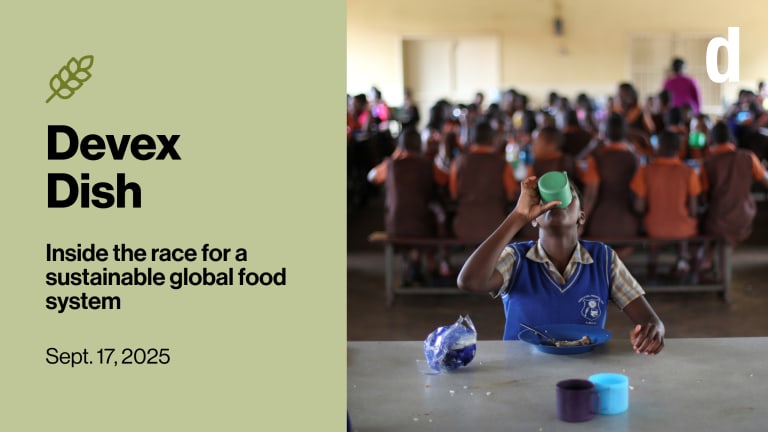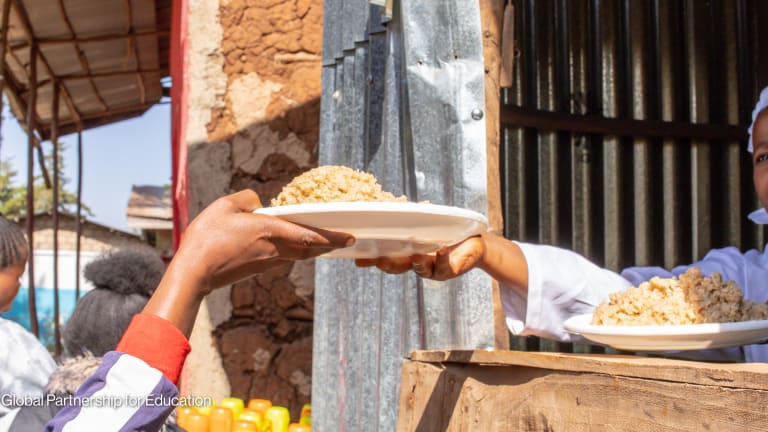National leadership and innovative financing fuel a school meals boom
Governments are leading a global push to expand school meals, pairing creative financing with local food sourcing, climate-smart menus, and cross-country collaboration to reach more children.
School meals are one of the most widespread social programs in the world — and they’re expanding fast. In 2022, 418 million children received school meals around the world — an increase of 30 million since early 2020, according to the World Food Programme. Over that period, global investment in school meals increased by $5 billion. From Indonesia’s launch of what could become one of the world’s largest programs to Brazil’s internationally renowned model for feeding millions, governments are making big investments. Several countries have set out strategies for achieving universal coverage, and philanthropic commitments — such as The Rockefeller Foundation’s $100 million pledge earlier this year — are adding momentum. But while international donors and NGOs play a role, governments lead the way in funding and delivering school meals. That leadership, said Carmen Burbano de Lara, director of the School Meals Coalition, whose secretariat and coordinating body is WFP, has made this a rare bright spot in global development — one she called “probably the most important development success story in recent years.” Launched at the 2021 U.N. Food Systems Summit, the coalition now includes 109 countries and 140 partners, working to restore programs disrupted by the COVID-19 pandemic, reach the most vulnerable children, and improve the quality of lunches by 2030. Devex caught up with Burbano de Lara on the sidelines of U.N. Food Systems Summit +4 Stocktake, or UNFSS+4, in Addis Ababa in July to discuss progress, financing innovations, and how countries are working together. This conversation has been edited for length and clarity. Since the coalition launched in 2021, what are some standout success stories? Africa has expanded its programs by 20 million children just in the last two years. … Ninety-eight percent of it is government budgets. Government stepping up and not in a small way. Ethiopia has, since they joined the School Meals Coalition in 2021, expanded their program fivefold from about 1.6 million kids to 7.5 million kids. According to [a government minister at UNFSS+4], they went from allocating $11 million of the national budget to school meals to now $127 million. Kenya is interesting because the government decided to focus not just on scaling access to meals, but also on the connection to the local procurement of food, so that at the same time that they’re feeding children, they can also provide market access for farmers and create jobs. The other thing that they’ve done is that they’ve started to look at sustainability. So, for example, inclusion of drought-resistant crops into the program. And the government is signaling to the market what crops are adaptable. How is the current funding environment affecting school meal programs? We are concerned about the lowest-income countries. That’s where the coverage is the lowest and continues to be the lowest, even though governments have stepped up and donors have stepped up. We’re working with governments on this — for example, working with ministries of finance to put together financing strategies. And we’re looking at resource mobilization that can be both domestic and international. What are some exciting funding innovations in this space? In some Latin American countries, we’re seeing taxes on public “bads” that are then helping to fund public “goods,” such as school meals. In Bolivia, for example, there are hydrocarbon taxes that are putting money into school meals. Some other countries are exploring taxes on sugary drinks, taxes on alcohol and tobacco, and products that are bad for people’s health. And so you’re reversing and kind of incentivizing good behaviors by taxing bad behaviors at the same time. And there’s conversations around debt swaps. Kenya is in the process of negotiating a debt swap for school meals. This is an interesting case where the creditor country says, “Well, OK. We’ll swap your debt if the equivalent amount of funding is going to the national school meal program,” which is what has been happening. So I think that’s a very attractive proposition to creditor countries because school meals are such a good investment. Data is telling us that for every dollar that you invest in school meals, somewhere between $7 and $35 are put back into the economies because of the benefits to agriculture, the benefits to job creation, the benefits of kids going into school. At the end of the day, you really put it back in the economy many, many times over. The Islamic Development Bank has just worked with us at WFP on a new human capital initiative that provides a mix of grants and loans to countries for school meal programs. The African Development Bank just announced last year a school meals initiative with the help of philanthropies in Africa. And we’re having some conversations on the clean cooking agenda: If governments switch to [electric or other clean energy stoves], for example, how can they then derive carbon credits out of those projects and out of those infrastructure investments that they’re making? So there are conversations in terms of how climate finance can help support this agenda. What’s the role of the private sector? The private sector is very important for the programs, but, of course, then you have to kind of break it down into which private sector we’re talking about. The natural partner is the farming sector. So you could be looking at smallholder farmer associations and different levels all the way up to food companies and large agribusiness, and large catering companies that are providing food in different country programs. In many countries, these companies provide pieces of the program with specific foods, and then smallholder farmers come in and complement, for example, with fresh produce that can be found closer to the schools. There are other elements of the private sector that we're trying to tap into, such as the private sector providing know-how in supply chains, in guaranteeing food safety, for example. The private sector has a lot of technology improvements and know-how that it can contribute, both to countries but also to the international community, to try and figure out if we can develop standards, if we can start to develop better ways of doing supply chain management, particularly in places where that might be difficult. [Indonesia’s free school meals program has been hit by repeated mass food poisoning outbreaks since its launch in January.] The other element that we’ve been trying to develop is a code of conduct for the food industry. And while obviously the majority of the food industry plays a positive role, the introduction, for example, of ultra-processed food in schools … that’s something that we are constantly trying to figure out: how do we help governments regulate that? What kind of role does technology play in school meal programming? One of the big questions now is how AI can help improve the efficiency of the programs, improve the way governments make decisions. We have, for example, developed an app called School Meal Plus that we’ve been working on for many years now, which helps governments, particularly local governments, make decisions on what the menus should look like, given what’s being produced locally, given nutritional standards that the government sets, and given costs. And so those three variables, if you plug them into the app, then it’ll give you menus. Around 20 governments are now using it. It’s publicly available for free, and it’s constantly upgraded, also based on the information that we get for each country and what they’re producing. How does the coalition foster collaboration, and what’s next? One of its innovations is that it broke the paradigm of donor-recipient. When countries join the coalition, they join from a domestic perspective. So, France is a member of the coalition, just as Indonesia, Malawi, Japan, and Ecuador. And all of these countries are there to discuss domestic policy. They’re not there as, “I’m the donor and you’re the recipient” — that logic in the coalition doesn’t exist. So there’s been a lot of sharing and learning and understanding who’s doing what. So we try to support countries in increasing the dialogue between them. This happens through virtual meetings every two months. And there’s in-person meetings that happen every two years. The next big in-person ministerial summit is happening in Brazil on the 18th and 19th of September, hosted by President [Luiz Inácio] Lula [da Silva], where all the countries and all the partners of the coalition will join in person and have two days of conversations. A couple of years ago, the regions started to say, “Well, we want regional conversations, too.” And they started organizing themselves in regional meetings. So, Latin America has had three regional meetings so far. We’ve already seen two meetings from the West African group led by ECOWAS. The East Africa group of countries has created a network, a regional School Meals Coalition network, so they have their own meetings in the region. Asia had its first regional meeting last year, hosted by Cambodia. This is all government-led and initiated. At these moments internationally, it’s very hard to get governments to agree on anything. This is a new paradigm of multilateralism that is emerging where governments are focusing on a concrete, kind of aligning on a very concrete, doable, practical goal, and demonstrating that it could be done.
School meals are one of the most widespread social programs in the world — and they’re expanding fast. In 2022, 418 million children received school meals around the world — an increase of 30 million since early 2020, according to the World Food Programme. Over that period, global investment in school meals increased by $5 billion. From Indonesia’s launch of what could become one of the world’s largest programs to Brazil’s internationally renowned model for feeding millions, governments are making big investments. Several countries have set out strategies for achieving universal coverage, and philanthropic commitments — such as The Rockefeller Foundation’s $100 million pledge earlier this year — are adding momentum.
But while international donors and NGOs play a role, governments lead the way in funding and delivering school meals. That leadership, said Carmen Burbano de Lara, director of the School Meals Coalition, whose secretariat and coordinating body is WFP, has made this a rare bright spot in global development — one she called “probably the most important development success story in recent years.”
Launched at the 2021 U.N. Food Systems Summit, the coalition now includes 109 countries and 140 partners, working to restore programs disrupted by the COVID-19 pandemic, reach the most vulnerable children, and improve the quality of lunches by 2030. Devex caught up with Burbano de Lara on the sidelines of U.N. Food Systems Summit +4 Stocktake, or UNFSS+4, in Addis Ababa in July to discuss progress, financing innovations, and how countries are working together.
This article is free to read - just register or sign in
Access news, newsletters, events and more.
Join usSign inPrinting articles to share with others is a breach of our terms and conditions and copyright policy. Please use the sharing options on the left side of the article. Devex Pro members may share up to 10 articles per month using the Pro share tool ( ).
Ayenat Mersie is a Global Development Reporter for Devex. Previously, she worked as a freelance journalist for publications such as National Geographic and Foreign Policy and as an East Africa correspondent for Reuters.








